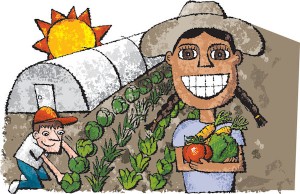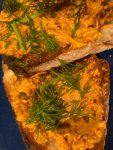Home, Heart, Hands, Health
4H and the Future of Farming
It’s a warm July evening at the Saline County Fairgrounds and I am walking on the main thoroughfare toward Shed B. The Fairgrounds parking lot is filled with cars, pickups, horse trailers and livestock haulers of all makes and models. Families stroll through the fairgrounds, the children pulling the arms of their parents in the direction of another shed or one of the many enormous striped tents erected over animal stalls and pens. Simple signs nailed to the tent posts announce the occupants: “Sheep.” “Goats.” The place is crowded, and the air buzzes with anticipation.
I see Alex Young standing in front of Shed B, talking on his cell. “I’m here. Where are you guys?” He sees me and waves me over. Shed B is an enormous building with a roof, but no walls. Under the roof is a temporary corral strewn with hay and surrounded on three sides by stadium bleachers. The fourth side is a high wall hung with green bunting and a sign that reads “Washtenaw County 4H Youth Fair.”
Alex hangs up and we chat. This is my first 4H auction, and he’s giving me the rough order in which things will happen. Alex will buy a handful of animals this evening destined for the tables at Zingerman’s Roadhouse, as well as a couple for the herd at Cornman Farms. As we talk, several people stop by to say hello to Alex and they talk a little shop, speculating on the prices and condition of the animals. The atmosphere is one of friendly competition. “To me,” Alex tells me, “the beauty of 4H, is that it’s a community thing. It strengthens the bond between farmers.” In a little while, the people here will bid against each other for prize-winning cows, hogs, lambs, goats, turkeys, chickens, and even rabbits. And it’s all done in the name of a most worthy cause for all in attendance: the young farmers.
The 4H Youth Development Organization, known by it’s distinctive four-leaf clover symbol, has its roots in the early 20th
century efforts of an Ohio school principal named A.B. Graham. By promoting vocational agriculture in out-of-school clubs, Graham sought to arrest the decline of post-industrial revolution farming as young people left their rural roots for jobs in the city. Eventually, he partnered with the Ohio Agricultural Experiment Station and the Ohio State University. His clubs are considered the founding of 4H.
The club’s logo, a four-leaf clover with the letter “H” on each of the leaves, symbolizes the four values that club members work toward through the organization’s programs:
Head – Managing, Thinking
Heart – Relating, Caring
Hands – Giving, Working
Health – Being, Living
The activities this week are the culmination of a season (sometimes two!) of work on the part of the kids in 4H. This is fundamentally an exercise for the kids to learn the business of running a farm. They’re charged with raising an animal from birth, taking responsibility for its growth and development, and preparing for the day when they’ll compete with other 4H kids in the judging portion of the fair (which happened earlier in the week). The animals are entered into different classes and the kids are evaluated by their knowledge of the animal, and its overall condition (how well it was raised). These classes produce the top of class Champions and Reserve Champions that will garner the most attention and money at tonight’s auction. The young club members will parade their animals in front of an audience of family, friends, and neighbors while the auctioneer barks and prices hopefully go up.
The rest of the Young clan has joined Alex and I, and we make our way to the registration table just before the auction is set to begin. The 4H folks give Alex a packet of papers that includes a detailed list of the animals up for auction, and an orange bidding card with “888” written in magic marker. The numbers are issued once to each bidder, and this becomes their number for all time. As the numbers are issued in chronological order, so the lower the number, the longer the bidder has been involved in the 4H auction. As we’re seated, Alex greets an elderly couple in front of us. I notice that their bidding number is in the low single digits. Alex smiles and says, “Yup, they’ve been coming here a long time.”
Just after we sit down, the staff and auctioneer take their places behind the high green wall overlooking the corral and the auction begins. The north gate on the corral opens, and a teenage girl dressed in a plaid shirt and new jeans enters, smiling, with two of largest hogs I’ve ever seen. She parades the animals around the ring, keeping them in the center by touching their sides with a long, slender stick. Alex informs me that the breed is Chester White, which translates into a standard pinkish color on the actual pig.
The auctioneer is calling out the price per pound, which is how these animals are sold. “Starting out at two-ten. Two-ten now, can I get two-twenty?” At the edge of the ring stand several men whose job is spot bidders in the crowd and relay their bids to the auctioneer. The divide up the audience into thirds, scanning the bleachers for a raised orange bidding card. When they spot one, they let out a sort of cross between a word and a whoop. It reminds me of listening to a baseball umpire calling strikes or balls; the word itself is indecipherable, but the sound is emphatic.
“How about two-thirty? Two-thirty, two-thirty…” In answer, one of the spotters points to a bidder and yells, “Hunh-YEAH!!” The auctioneer barely slows down. “Two-forty, two-forty now. I have two-thirty, two-forty now. Two-forty…” Another spotter: “HOOP!” “Two-fifty now…” And on it goes until the bidding peters out, and the auctioneer ends the process, “Three-twenty? Nope? Three-ten, then. Once…? Twice…?” No reply from the crowd.
The auctioneer points to the winning bidder, “Three-ten. To bidder number…?” The spotter calls out the bidder’s number, which is recorded by a smiling woman to the right of the auctioneer. She consults a sheaf of paper, then reads out the winning bidder’s name. The audience applauds, and the teenager moves her hogs out of the ring to make way for the next pair.
Each of those hogs weighed roughly 300 pounds, and they sold for $3.10 per pound. Doing the math, I realize the winning bidder just paid nearly $2000 for the pair. Alex smiles, and nods. “Animals are expensive. Farming requires a significant investment for what is essentially a gamble.” And he’s right. A lot of things could happen to bring down the auction price. Disease, accident, or simply a lower-paying market. Factor in all the time, care, feed, and vet costs, and there is the possibility that these kids might not realize a good return on their initial investment. They might even lose money. This seems a tough, but necessary lesson about the farming life. For all the bucolic idealism we attach to the rural life, farming is still a business. And sometimes it’s a very tough business.
The bidding continues until hogs raised by Alex’s son Ethan come trotting into the ring. Alex is active in the bidding process, and price goes up. For a time, it looks like he might let the hogs go to a couple of other aggressive bidders, but at the last minute he jumps in with the winning bid. He tells me it isn’t all that unusual for friends and family to buy the animals of the 4H clubbers. While the idea is to teach the kids how the farming business works, community comes first. No one wants to disappoint the hopeful faces of the kids in the ring.
But the kids take their business lessons to heart. While we’re waiting for the next round of bidding, Kelly Young shows me some of the letters sent by 4H kids asking bidders to consider buying their animals. The letters are polite, and filled with details about the care of the animals. It’s charming to read their young sales pitches, but the letters are surprisingly effective and I find myself hoping these kids sell their animals at the highest price possible. As I’m reading the letters, another auction ends and I notice something else happening. The kids are seeking out the people who bought their animals, and giving them thank-you gifts. Usually, it’s something homemade, like cookies, along with a note of appreciation. In this noisy, crowded environment, it’s a touching gesture. Lessons well-learned, indeed.
As the auction moves from hogs to cows, sheep, and goats, Alex buys a lamb and two goats to add to the Cornman Farms herd. When the auction moves on to poultry, Alex points out some bidders from Meijer, Busch’s, and a couple of other food retail outfits. But, I say, surely, this isn’t an efficient way for them to source poultry for their respective chains? Alex tells me that these companies often buy from 4H auctions to donate to local food banks and shelters. It seems that 4H auctions bring out the best in everyone.
When I ask Alex to sum up the 4H experience, he says, “We need more farmers. Until very recently, the number of kids going into farming was on the decline. By having kids participate in 4H, we increase the likelihood that more of these kids will become farmers.” But, the positive impact reaches far beyond the local agrarian community. The implications are important for our country, as well. Simply put, “Our food is better for having more farmers,” says Alex. “If there are more farmers, we have more competition, and therefore a better selection of food. It’s important to keep our food supply healthy.”
As the evening winds down, the bleacher crowds thin out and people begin to drift away to gather in knots and talk. There’s a lot of laughter and everyone seems to be smiling. Alex and Kelly move through the crowd, stopping to chat, and talk about the upcoming Chelsea Community Fair happening in a few weeks. The Chelsea fair will also include an auction, so tonight’s process will be repeated with another herd of animals, another crowd of families and hopeful kids. It all fits neatly into the ancient cycles of the agrarian year, a continuous circle of renewal and harvest, of enjoying the bountiful gifts of the farming life.




Zingerman’s Art for Sale